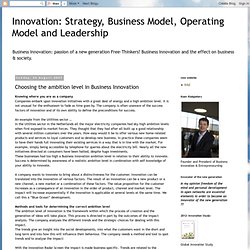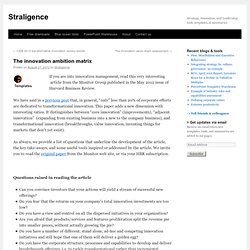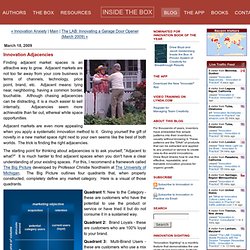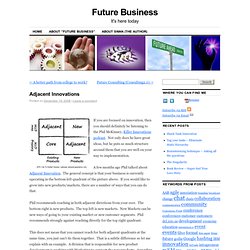

Forecasting Success in Innovation Teams. A 2012 study by the Harvard Business Review surfaced several interesting findings about the practice of innovation for the enterprise, including the innovation ambition matrix, which details how “firms that excel at total innovation management simultaneously invest at three levels of ambition, carefully managing the balance among them.”

To read more about the Harvard Business Review study please click here. Those three levels are: Core: When organizations are refining their existing offering.Adjacent: When companies are expanding their offering into business that is new for them.Transformational: When companies are developing offerings in markets that don’t exist yet. But beyond that, the article makes some very concrete recommendations for organizational innovation programs: Multi-disciplinary innovation teams: Innovation teams should be composed of a varied skill set that can manage numerous challenges.
By Rob Hoehn About the author Photo: Businessman Presenting by Shutterstock.com. Strategy, Business Model, Operating Model and Leadership: Choosing the ambition level in Business Innovation. Knowing where you are as a companyCompanies embark upon innovation initiatives with a great deal of energy and a high ambition level.

It is not unusual for the enthusiasm to fade as time goes by. The company is often unaware of the success factors of innovation and of its own ability to define the preconditions for success. An example from the Utilities sector …In the Utilities sector in the Netherlands all the major electricity companies had sky-high ambition levels when first exposed to market forces. They thought that they had after all built up a good relationship with several million customers over the years. How easy would it be to offer various new home-related products and services to loyal customers and so develop new business. A company wants to innovate to bring about a distinctiveness for the customer.
With the Innovation Radar Screen the impact is made business-specific. R1205C A LG. The innovation ambition matrix. If you are into innovation management, read this very interesting article from the Monitor Group published in the May 2012 issue of Harvard Business Review.

We have said in a previous post that, in general, “only” less than 20% of corporate efforts are dedicated to transformational innovation. This paper adds a new dimension with interesting ratios. It distinguishes between “core innovation” (improvements), “adjacent innovation” (expanding from existing business into a new to the company business), and transformational innovation (breakthroughs, value innovation, inventing things for markets that don’t yet exist). As always, we provide a list of questions that underline the development of the article, the key take-aways, and some useful tools inspired or addressed by the article. We invite you to read the original paper from the Monitor web site, or via your HBR subscription.
Questions raised in reading the article Take-aways – Key questions answered by the article Conclusion. Innovation Adjacencies. Finding adjacent market spaces is an attractive way to grow.

Adjacent markets are not too far away from your core business in terms of channels, technology, price point, brand, etc. Adjacent means: lying near, neighboring, having a common border, touchable. Although chasing adjacencies can be distracting, it is a much easier to sell internally. Adjacencies seem more achievable than far out, ethereal white space opportunities. Innovation: Core, Adjacent, Transformational. Adjacent Innovations. If you are focused on innovation, then you should definitely be listening to the Phil McKinney, Killer Innovations podcast.

Not only does he have great ideas, but he puts so much structure around them that you are well on your way to implementation. A few months ago Phil talked about Adjacent Innovation. The general concept is that your business is currently operating in the bottom left quadrant of the picture above. If you would like to grow into new products/markets, there are a number of ways that you can do that. Phil recommends reaching in both adjacent directions from your core. This does not mean that you cannot reach for both adjacent quadrants at the same time, you just can’t do them together. What this does for you is create an effort/experience that is not too foreign to your people or your market and therefore affords a much greater chance for success. R1205C A LG. Managing Your Innovation Portfolio. Artwork: Ricky Allman, We Can See You, 2010, acrylic on panel, 12" x 16" Management knows it and so does Wall Street: The year-to-year viability of a company depends on its ability to innovate.

Given today’s market expectations, global competitive pressures, and the extent and pace of structural change, this is truer than ever. But chief executives struggle to make the case to the Street that their managerial actions can be relied on to yield a stream of successful new offerings. Many admit to being unsure and frustrated. Typically they are aware of a tremendous amount of innovation going on inside their enterprises but don’t feel they have a grasp on all the dispersed initiatives.
Making matters worse, executives tend to respond with dramatic interventions and vacillating strategies. We tell this story because it is typical of companies that have not yet learned to manage innovation strategically. Growth Outside the Core. The Idea in Brief Seventy-five percent of growth initiatives fail.

So how do the few firms that generate sustained, profitable growth succeed? They expand their strong, core businesses—in predictable, repeatable ways—into related markets where they can excel. For example, they may continue to focus on their core products, but sell them in new geographic regions, through new distribution channels, or to new customer segments. Such companies develop—and rigorously apply—a strict repeatability formula to these adjacency moves. The payoff? The Idea in Practice.